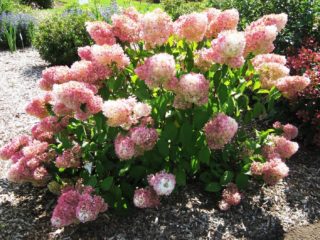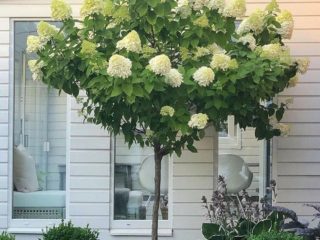Content
Pruning viburnum buldenezh is an important operation that allows you to form a healthy, rapidly developing and abundantly flowering shrub. The procedure is carried out using a certain technique, depending on the time of year and the purpose of the haircut.

The ornamental shrub is unpretentious and blooms profusely if properly pruned and shaped.
Is viburnum buldenezh pruned?
Viburnum buldenezh (Viburnum Boulle-de-neig) grows very quickly. The annual growth is at least 40 cm. If you do not form its crown, the branches will be arranged chaotically, resulting in the formation of thickets that do not have an aesthetic appearance. Untimely and incorrect pruning leads to thickening of the bush, lack of proper ventilation, and insufficient lighting in its center. As a result, viburnum buldenezh begins to hurt, it is attacked by pests, the branches dry out and die.
With proper care, the shrub blooms profusely, decorating the landscape of the site for at least 20 years.Pruning is necessary for the plant to rejuvenate and produce larger foliage and inflorescences. For sanitary purposes, remove old, dry, diseased or damaged shoots.
Should I prune viburnum buldenezh after flowering?
Flowering viburnum Buldenezh begins in early summer and lasts about five weeks. The snow-white inflorescences look very impressive, their diameter reaches 15 cm. Under their weight, the branches bend down, forming a cascade of white balls. The carved foliage of the bush also looks decorative, the beautiful appearance of which remains throughout the season.
In summer, viburnum buldenezh can be pruned twice. The first time, shoots that stray from the general shape are carefully cut off to reveal the inflorescences hidden in the green foliage.
The second main pruning begins in mid-July, after flowering has ended. During this period, you can start shaping the bush, giving it any shape to successfully fit into the garden design.
When pruning viburnum buldenezh in summer, first of all, wilted inflorescences and lower, strongly bent shoots are removed. Then they pay attention to the branches inside the bush. Those whose growth is directed towards its center should be cut out.
If there is an impressive gap inside due to the lack of branches, choose one shoot nearby, and make a cut at an angle of 45⁰ above the bud directed towards the hole.
Trimming the viburnum buldenezh after flowering should be combined with treating the crown against pests and feeding the plant.

Without pruning and shaping, some varieties can reach a height of 4 m
When can you prune viburnum buldenezh?
Pruning is a traumatic operation, so it is best done during the rest period, when sap flow stops. The most favorable time begins after the leaves fall and ends with the buds opening. In winter, it is not worthwhile to shape viburnum buldenezh, since its branches are fragile and can easily damage the plant.
Rules and schemes for pruning viburnum buldenezh
The pruning procedure is not considered complicated, but before you start forming the crown of a bush, you should familiarize yourself with the general rules:
- The instrument is disinfected in advance.
- Branches with a diameter of less than 5 mm are cut with pruning shears; for the rest, a lopper is used.
- The cut is made at an angle, 5 mm above the bud.
- The wound is treated with garden varnish.
- Crown formation begins after the first year of life.
- When creating original forms, you should not deviate too far from the natural one, so as not to disrupt the natural development of the plant.
- Sick and frozen shoots are removed without pity, since in the future they can become a source of infection and provoke a surge in diseases.
- After pruning, damaged branches should be burned outside the site.
- The formation procedure is carried out at least twice a year.
The garden tools used (saw, lopper, pruner, knife) must be made of high quality metal and sharply sharpened.
There are three types of pruning ornamental shrubs:
- Formative.
- Rejuvenating.
- Sanitary.
Depending on the age of the plant and its condition, choose the type of haircut.

After pruning the bush, at least eight skeletal branches should remain
Formative
Determined by the future shape and height of the bush. Then proceed according to the scheme:
- After planting, shorten all shoots to three buds.
- New ones, grown at the beginning of the season, are pinched as soon as their length exceeds 30 cm.
- In spring, the strongest branches are selected and their lateral growth is stimulated by pruning by a third.
- The shoots are cut out.
- The height of the main shoots is limited after they reach the required length.
Rejuvenating
Old viburnum buldenezh should be pruned no earlier than six years after planting. If the flowering has become weak, the leaves are small, and the berries are not set, then it’s time to rejuvenate the bush. For this purpose, the oldest branches are cut out (three to four per year). Gradually the plant will renew itself.
Sanitary
This type of pruning and shaping is necessary for the health of the plant. For this purpose, they remove broken branches or saw off their parts, cut out diseased and dry ones, and cut off bunches of berries.
In order to distinguish dry branches from living and healthy ones after leaf fall, you need to pay attention to the bark. When dead, it is dull, covered with wrinkles or raised dots, and when scraped, you can see not green, but dry wood underneath.
How to form viburnum buldenezh on a standard
The shape of the viburnum, which has one trunk, looks very original. The goal is to obtain a wide crown on a high or low trunk. To form viburnum buldenezh into a tree, you need to follow the pruning algorithm:
- After the seedling has rooted, it should not be formed for two years.
- In the third year, select the strongest shoot and remove the rest.
- Grow it for two to three years, removing side branches to a height of 40 cm.
- After the trunk reaches 1.5 m, the growth point is shortened by 30 cm.
- The next year, the resulting fork is pinched.
- Side branches are used to form the crown.

To improve the “healing” of cuts, they are treated with a solution of copper sulfate and then with garden pitch.
The tree looks impressive, but its trunk is often crooked and not strong and reliable enough. A gust of wind can break it. For strengthening, supports are used - stakes, pipes, poles. Gardeners note that the yield of viburnum grown on a trunk is somewhat lower than that of bush ones.
How to prune and shape viburnum buldenezh in spring
Spring pruning of viburnum has several purposes at once - it is carried out for sanitary cleaning, formation and thinning of the bush. In addition to diseased specimens, frozen branches must be removed during this period. Their appearance is exactly the same as dry ones; they are cut off above the bud.
To trim viburnum buldenezh in the spring for the purpose of thinning, proceed according to plan:
- Tops are removed - shoots of the second order, growing vertically upward.
- Cut out all the branches whose growth direction is downward or inside the bush.
- If the shoots rub against each other, only the strongest and healthiest are left.
- They cut off the umbrellas left after the berries.
Shaping and pruning are necessary for young viburnum. With their help, they give the bush any appearance, including that of a tree. Spring is the most suitable time for this. If you do not prune the viburnum buldenezh according to all the rules, soon its height will reach 2-3 m. To form a beautiful bush, easy to maintain and harmoniously fit into the landscape, leave up to seven of the most powerful shoots, after which their growth is limited to the height of an arm extended upward . Using pruning, an ornamental plant can be shaped into a ball, cube or hemisphere.

After effective pruning, viburnum can solo in single plantings, in compositions, or serve as a hedge.
How to properly prune and shape viburnum buldenezh after flowering, in the fall
When starting pruning in the fall, you should remember that it is impossible to predict what the coming winter will be like. If there is a large amount of snow, branches can break under its thickness. If the shoots are greatly shortened during autumn formation, frost can complete the process and the entire viburnum bush will die. You should not carry out thinning pruning in the fall. A lush bush has a much higher chance of surviving the winter. During the winter cold, the branches protect each other from wind and frost. If the crown is thick, snow lingers on it and serves as additional shelter for the plant.
In autumn, only dry, diseased and broken branches should be removed. They are cut out to the healthy part above the kidney. It should be directed not inward, but outward of the bush. Broken shoots are removed onto a stump, the cut is made parallel to the trunk with a distance of 5 mm from it.
Depending on the age of the plant, autumn pruning and shaping differ:
- Young bushes - in the first year they only pinch shoots.
- Old - remove branches of the second order, growing up or down.
Conclusion
Pruning viburnum buldenezh requires special knowledge, skills and abilities from the gardener. It’s easy to purchase them, just follow the recommendations. If you carry out the procedure in compliance with the deadlines and rules, the viburnum bushes will look great after formation, delight you with luxurious flowering and a rich harvest of berries.








